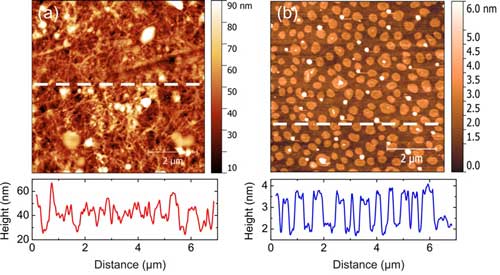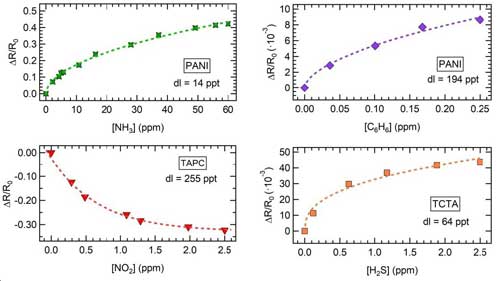| May 13, 2020 | |
Carbon nanotubes pave the way for human breath analysis of lung disease |
|
| (Nanowerk Spotlight) Point-of-care health monitoring is still a challenging technology under development. Various sensors can be integrated into wearable devices for the monitoring of different health parameters like temperature and pulse rate. However to provide deep health analyses and a prediction for the existence of disease still requires the use of complicated diagnostic tools like MRI, computer tomography, etc, or body liquids analysis from blood, saliva, etc. | |
| Breath is one of the main sources of human health parameters that can be used for predicting the state of different internal organs. Exhaled breath composition is very complex and the existence of disease marker molecules can be as low as 1 ppm (one part per million). That means that using breath for health monitoring purposes requires highly sensitive tools with a recognition ability down to single molecules. | |
| Among a number of methods for breath analysis the most promising one is based on the concept of electronic nose. Here, the task for certain disease pattern recognition is moves from hardware to software using advanced methods of data analysis. This concept provides both miniaturization of sensor designs and fast response times. Yet the development of sensor platforms that provide high sensitivity to the informative molecules with high humidity background in the exhaled breath is still challenging. | |
| A team of researchers from Università Cattolica del Sacro Cuore (Italy), Skolkovo Institute of Science and Technology (Russia) and National Research University of Electronic Technology (Russia), has developed a method for fast, on-site and still accurate breath analysis that does not need special preparation of breath samples. The method is based on an electronic nose platform that uses a set of single-walled carbon nanotube (SWCNTs) sensors deposited on flexible substrates and modified by different semiconducting organic molecules. | |
| Carbon nanotubes are widely used for electronic nose development because of their high sensitivity to environmental gases, high stability, and intrinsic variations in electronic properties that makes them perfect for use in electronic nose platforms. The researchers suggested improving the recognition properties of the SWCNT sensors by additional functionalization that increases the sensors' specificity to different gases, making sub-ppm analysis possible. | |
| The scientists reported their findings in Advanced Healthcare Materials ("Development of a Sensing Array for Human Breath Analysis Based on SWCNT Layers Functionalized with Semiconductor Organic Molecules"). | |
 |
|
| Image shows SWCNT films on PET covered by monolayers of organic molecule crystals (left). For comparison, AFM images of molecules deposited in the same process on satellite glass substrates are shown in the right panel. The corresponding cross-sections (white lines) are shown below the images. (Image: National Research University of Electronic Technology) (click on image to enlarge) | |
| The researchers demonstrated the performance of this method by analyzing Various gases and vapors (ammonia, ethanol, acetone, 2-propanol, sodium hypochlorite, benzene, hydrogen sulfide, and nitrogen dioxide). The sensitivity was demonstrated down to 0.25 ppm for each nanotube sensor area of about 1 cm2 with high level of discrimination between gases. The best detection limit was demonstrated for ammonia for nanotubes covered by PANI molecules and hydrogen sulfide for CNT covered by TCTA molecules of 0.014 and 0.064 ppm, respectively. | |
| Moreover, the team demonstrated that these sensors can be used for chronic obstructive pulmonary disease (COPD) recognition based on breath analyses of 21 individuals. Advanced data analysis methods based on principle component analyses provided a clear distinction between subjects with and without COPD. | |
 |
|
| Calibration curve of resistance change vs. target gas concentration and detection limit (dl) for the best performing sensors to NH3, NO2, H2S and C6H6 exposures. (Image: National Research University of Electronic Technology) (click on image to enlarge) | |
| The research team, led by Prof. L. Sangaletti, has demonstrated the high performance of their proposed sensing platform in breath recognition with relatively fast response times without the need for complicated breath treatment. In the case of COPD, they observed that the analysis can be improved by proper targeting the molecules specific to the decease. | |
| The main benefit of such an electronic nose platform is the possibility of future miniaturization and integration on a chip compatible with conventional microelectronics technologies, paving the way for on-site analysis using smartphones. | |
| This project was funded in part by the ANAPNOI project (Catholic University of the Sacred Heart) and the Russian Science Foundation. | |
|
A Nanowerk exclusive provided by National Research University of Electronic Technology
|
|
|
Become a Spotlight guest author! Join our large and growing group of guest contributors. Have you just published a scientific paper or have other exciting developments to share with the nanotechnology community? Here is how to publish on nanowerk.com. |
|
